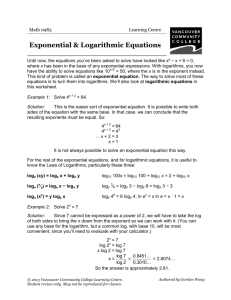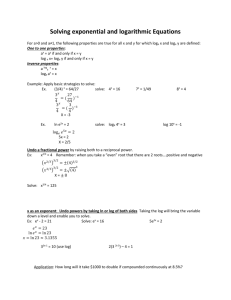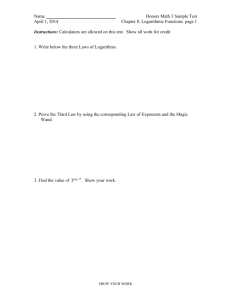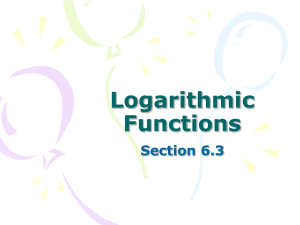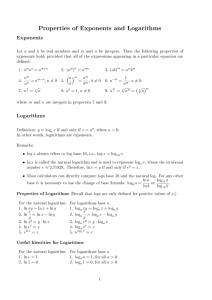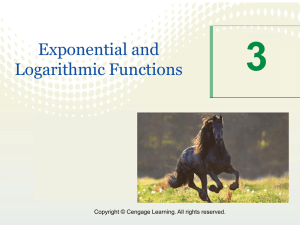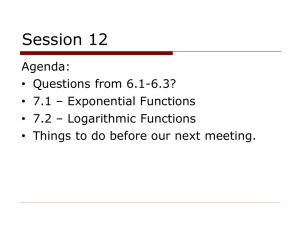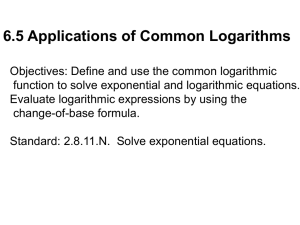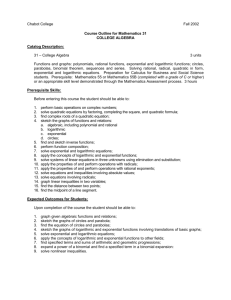Chapter 5: Exponential and Logarithmic Functions
advertisement
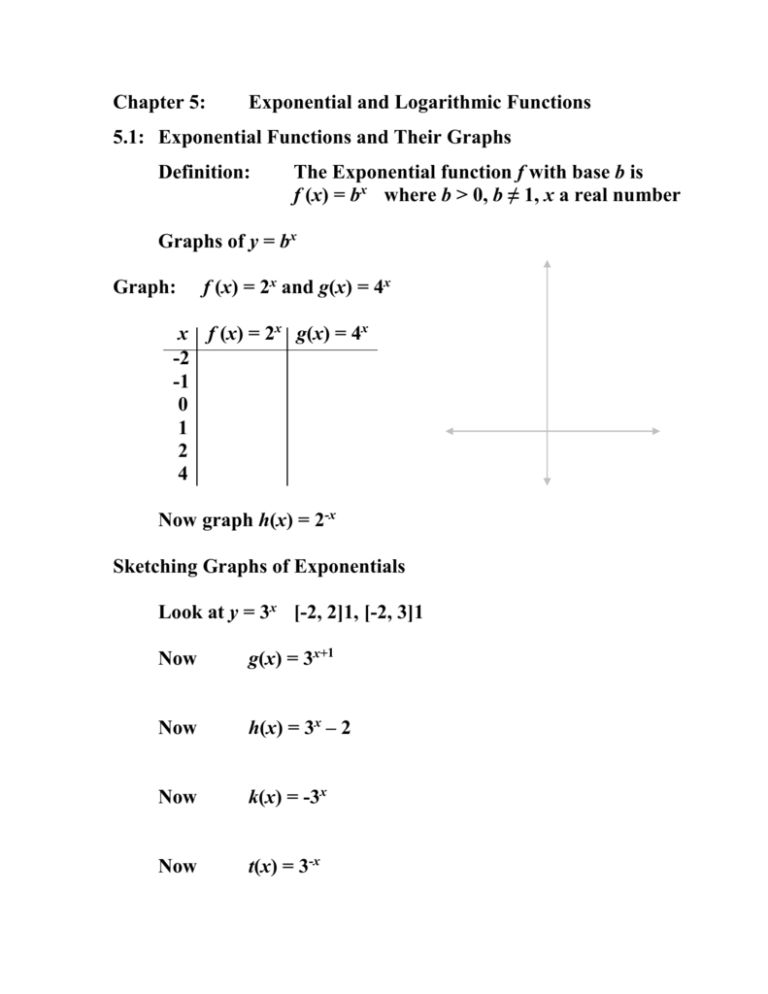
Chapter 5: Exponential and Logarithmic Functions 5.1: Exponential Functions and Their Graphs Definition: The Exponential function f with base b is f (x) = bx where b > 0, b ≠ 1, x a real number Graphs of y = bx Graph: f (x) = 2x and g(x) = 4x x f (x) = 2x g(x) = 4x -2 -1 0 1 2 4 Now graph h(x) = 2-x Sketching Graphs of Exponentials Look at y = 3x [-2, 2]1, [-2, 3]1 Now g(x) = 3x+1 Now h(x) = 3x – 2 Now k(x) = -3x Now t(x) = 3-x The Natural Number e Let’s look at the expression: (1 + 1n )n Evaluate for n = 1, 10, 102, 103, 106 Graph: f (x) = ex Formulas for Compound Interest After t years, the balance A in an account with principal P and an annual interest rate r (in decimal form) is given by: 1. For n compounding per year: A = P( 1 + rn )nt 2. For continuous compounding: A = Pe r t Ex, A total of $12,000 is invested at an annual rate of 9%. Find the balance after 5 years if it is compounded : a) Quarterly b) Continuously EX 5.1, p 392-393: 1, 3, 5,7-10, 11-29 odd, 53, 65, 67. 5.2: Logarithmic Functions and Their Graphs Definition: Logarithmic Function For x > 0 and 0 < b ≠ 1 y = logb x if and only if x = by The function f (x) = logb x is called the logarithmic function with base b. For r > 0 and 0 < b ≠ 1, logb r = t ↔ bt = r Properties of Logarithms 1. logb 1 = 0 (because b0 = 1) 2. logb b = 1 (because b1 = b) 3. logb bx = x (because bx = bx) 4. If logb x = logb y then x = y Graphs of Logarithmic Functions Graph: f (x) = log10 x with calculator [-1,10]1,[-2,2]1 log10 x = log x Sketch: f (x) = log10 (x – 1) f (x) = 2 + log10 x The Natural Logarithm: f (x) = loge x or f (x) = ln x Properties of Natural Logarithms 1. ln 1 = 0 2. ln e = 1 3. ln ex = x 4. If ln x = ln y then x=y Find the domain of the following logarithmic functions: a) f (x) = ln (x – 2) b) f (x) = ln (2 – x) Ex 5.2, p 402-403: 1-37 odd, 39-44, 45, 53, 61, 65, 69, 73, 77, 79. 5.3: Properties of Logarithms Change-of-Base Formula Let a, b, and x be positive real numbers s.t. a ≠ 1 and b ≠ 1 bx Then loga x = log logb a Properties of Logarithms Let a be a positive real not equal to 1, and let n be a real number. If u and v are positive reals, then the following are true: 1. loga (uv) = loga (u) + loga (v) 1. ln (uv) = ln (u) + ln (v) 2. loga ( uv ) = loga (u) – loga (v) 2. ln ( uv ) = ln (u) – ln (v) 3. loga un = n loga u 3. ln un = n ln u Write ln 6 Verify: and 2 ln 27 in terms of ln 2 and ln 3 -ln 12 = ln 2 Rewrite the following expressions Condense the following Ex 5.3, pp 409-410: 1, 3, 9, 11, 17, 19, 23, 25, 33, 35, 39, 43, 47, 53, 61-65, 69, 73, 79. 5.4: Exponential and Logarithmic Equations Key Properties: 1. x=y 2. x=y Also, Solve: if and only if if and only if loga x = loga y ax = ay a > 0, a ≠ 1 loga ax = x and ln ex = x alogax = x and eln x = x ex = 7 e x + 5 = 60 4e 2x = 5 e 2x – 3e x + 2 = 0 ln x = 2 5 + 2 ln x = 4 2 ln 3x = 4 ln x – ln (x – 1) = 1 log10 5x + log10 (x – 1) = 2 Ex 5.4, pp 419-420: 1, 3, 9-17, 21, 25, 31, 47, 57, 75, 77, 91-97. 5.5: Exponential and Logarithmic Models The five most common types of mathematical models involving exponential functions are: 1. Exponential growth: y = ae bx , b > 0 2. Exponential decay: y = ae -bx , b > 0 2 3. Gaussian model: y = ae 4. Logistics growth: y= 5. Logarithmic models: -(x – b) /c ,b>0 a 1 + be - rx y = a + b ln x or y = a + b log x Estimates of number of households with Digital TVs (millions) are: Year 2003 Households 44.2 Model 43.9 2004 49.0 49.4 2005 55.5 55.5 2006 62.5 62.4 2007 70.3 70.2 The exponential model that approximates this data is: D = 30.92e 0.1171t , 3 < t < 7 In a research experiment, a population of fruit flies is increasing according to the law of exponential growth. After 2 days there are 100 flies, and after 4 days there are 300 flies. How many flies will there be after 5 days? Carbon Dating: The ratio of carbon 14 to carbon 12 in a recently discovered fossil is: R = 1 13 10 Estimate the age of the fossil when the ratio of carbon 14 to carbon 12 present at any time t is given by: R = 1 12 e -t/8223 10 In 1997, the SAT math scores for college-bound seniors roughly followed the following normal distribution: Ex 5, Spread of a Virus: On a college campus of 5000 students, one student returns from vacation with a contagious and long-lasting flu virus. The spread of the virus is modeled by: 5000 y= , 0<t 1 + 4999e - 0.8t where y is the number of students infected after t days. The college will cancel classes when 40% or more students are infected. a) b) How many students are infected after 5 days? After how many days will the college cancel classes? On the Richter scale, the magnitude R of an earthquake of intensity I: R = log10 I I0 where I0 = 1 Compare the intensity of the 2004 Sumatra quake of 9.0 to the Alaska quake of 6.8 in 2004. Ex 5.5, pp 430-432: 1-6, 7, 9, 13, 19, 25, 31-45 odd. Chapter 6: Systems of Equations and Inequalities 6.1: Linear and Nonlinear Systems of Equations A system of equations involves two or more equations with two or more variables. The following is an example of two equations in two unknown variables 2x + y = 5 Equation 1 3x – 2y = 4 Equation 2 Method of Substitution 1. Solve one equation for one variable in terms of the other. 2. Substitute expression of step 1 into other equation to obtain an equation in one variable. 3. Solve equation in step 2. 4. Substitute solution in step 3 into expression of step 1 for solution to other variable. 5. Check solution satisfies each original equation. Ex 6.1, pp 455-456: 1, 5, 11, 15, 25, 31. 6.2: Two-Variable Linear Systems Method of Elimination: 3x + 5y = 7 -3x – 2y = -1 4-Step Approach 1. Obtain coefficients for x (or y) that differ only in sign by multiplying all terms of one or both equations by suitably chosen constants. 2. Add the equations to eliminate one variable and solve the resulting equation. 3. Back-substitute the value obtained in step 2 into either of the original equations and solve for the other variable. 4. Check your solution in both of the original equations. Graphical Interpretation of Solutions It is possible for a general system of two linear equations in two unknowns to have: 1. Exactly one solution or 2. Infinitely many solutions or 3. No solution Ex 6.2, pp 467-468: 1, 3, 5, 7, 11, 17, 31-34, 35, 37.

